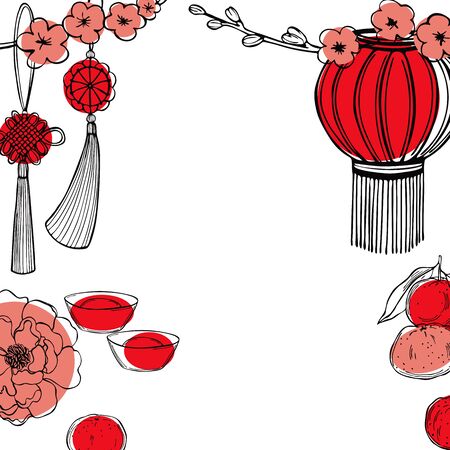1. Creating a Balanced Dining Atmosphere
Why Feng Shui Matters in the American Dining Room
When it comes to family meals, the environment you create can shape both your appetite and your relationships. Feng Shui, an ancient Chinese practice, offers easy-to-follow guidelines to help American families design dining rooms that encourage harmony, comfort, and connection. By blending these principles with modern American lifestyles—think open-concept spaces and cozy gatherings—you can make every meal more enjoyable.
Arranging Furniture for Togetherness
The way you set up your dining room furniture plays a big role in how your family interacts at mealtime. Here are some quick tips:
| Feng Shui Do’s | Feng Shui Don’ts |
|---|---|
| Choose a round or oval dining table to promote equality and conversation. | Avoid sharp-cornered tables that can create tension and interrupt energy flow. |
| Place chairs so everyone faces each other easily, supporting eye contact. | Don’t block doorways or windows with chairs or large furniture pieces. |
| Keep pathways around the table clear for easy movement and positive energy. | Avoid placing the table directly under overhead beams or in cramped corners. |
Lighting for Warmth and Connection
Lighting sets the mood for any gathering. In Feng Shui, soft, warm lighting helps foster an inviting atmosphere, perfect for heartfelt conversations and laughter at the dinner table. Consider these ideas:
- Use dimmable overhead lights or pendant lamps over the dining table for adjustable ambiance.
- Add candles or soft accent lights for special occasions.
- Avoid harsh fluorescent lighting, which can feel cold and unwelcoming.
Selecting Colors That Nurture Family Bonds
The colors you choose for your dining room walls, furniture, and decor can impact how relaxed and comfortable everyone feels. Here’s a simple guide:
| Color Choice | Feng Shui Effect | American Style Tip |
|---|---|---|
| Earth tones (beige, light brown) | Create a grounded, welcoming space | Pair with rustic wood accents for a farmhouse feel |
| Soft yellows & oranges | Energize conversations and appetites | Add as accent walls or chair cushions |
| Pale greens & blues | Promote calmness and relaxation | Mix with natural plants or botanical prints |
| Avoid bright reds on all walls | May cause restlessness if overused | Use sparingly—maybe just in artwork or napkins |
Blending Feng Shui with American Traditions
You don’t have to give up classic American touches like heirloom china cabinets or holiday centerpieces to practice good Feng Shui. Instead, focus on keeping the space clutter-free and welcoming. Showcase cherished items mindfully—just make sure they’re organized and not overwhelming the room’s energy.
2. Choosing the Right Dining Table and Seating
When it comes to creating a harmonious dining space, picking the right table and seating arrangement is key in Feng Shui and fits perfectly with the lifestyle of modern American families. The shape, material, and placement of your dining table can set the tone for how your family connects, shares meals, and enjoys quality time together.
Table Shapes: What’s Best for Family Harmony?
The shape of your dining table matters more than you might think. Each shape carries its own energy that can influence how people interact during meals. Here’s a quick guide to help you decide:
| Table Shape | Feng Shui Benefits | American Family Style |
|---|---|---|
| Round | Encourages equality and easy conversation; no sharp edges means smoother energy flow | Perfect for close-knit family dinners or game nights |
| Oval | Softens energy and supports inclusivity; great for larger gatherings | Ideal for holiday feasts or extended family meals |
| Rectangular | Symbolizes stability; best if corners are softened or not too sharp | Common in American homes, works well for everyday use |
| Square | Promotes balance but may limit interaction if too large | Good for smaller families or intimate settings |
Best Materials for Good Vibes
The material of your dining table also plays a role in attracting positive energy:
- Wood: Warm, inviting, and natural—wood tables support growth and connection.
- Glass: Looks sleek but can create an unstable feeling if used alone. Combine with wood or metal frames for balance.
- Metal: Modern and cool, but can feel cold. Add soft seat cushions or table runners to warm things up.
- Stone/Marble: Strong and grounding, but use softer colors to avoid feeling too heavy.
Dinner Seating: Arrangements That Bring People Together
Your seating layout should make everyone feel included and comfortable. In Feng Shui, it’s important to:
- Avoid placing chairs directly in line with doors—this can disrupt the flow of energy (and make guests feel uneasy).
- If possible, give each person enough personal space at the table without crowding.
- The head of the household often sits facing the main entrance for a sense of security and welcome.
- Add enough chairs so guests always have a place—an open seat symbolizes an open heart!
- If you use benches (a popular choice in many American homes), add cushions for comfort and warmth.
Quick Seating Arrangement Tips Table:
| Do’s | Don’ts |
|---|---|
| Circular seating for better conversation flow | Pushing one side against the wall (unless space is tight) |
| Sit so you see the entrance, not with your back to it | Sitting under overhead beams or harsh lighting |
Create a Welcoming Dining Experience Every Day!
The right table shape, materials, and seating arrangement set the scene for memorable meals and happy moments. With a little Feng Shui inspiration tailored to American family life, your dining room can truly become the heart of your home.

3. Decluttering and Organization Essentials
Keeping your dining room tidy and organized isn’t just about appearances—it’s a key Feng Shui principle that directly affects your family’s well-being and communication. For busy American families, a clutter-free space can make mealtimes more peaceful and enjoyable, while also encouraging open conversation and healthy connections.
Why Clutter Matters in Feng Shui
In Feng Shui, clutter is seen as blocked energy. When your dining area is messy, it can create stress, hinder digestion, and even lead to misunderstandings among family members. A clean dining room invites positive energy (or “chi”), helping everyone feel relaxed and welcome at the table.
Top Benefits of an Organized Dining Room
| Benefit | How It Helps Your Family |
|---|---|
| Easier Mealtimes | No need to clear off piles before eating—just sit down and enjoy! |
| Better Communication | A neat space lets everyone focus on each other, not the mess. |
| Less Stress | Visual order calms the mind and sets a positive tone for meals. |
| Saves Time | You’ll spend less time searching for things or cleaning up last minute. |
| Healthier Habits | A tidy table encourages mindful eating and togetherness. |
Simple Tips for Busy American Households
- Create a Drop Zone: Use a small basket or tray for mail, keys, or homework so these items don’t spread across the table.
- Daily 5-Minute Tidy-Up: Get the whole family involved in a quick pre-dinner clean-up routine.
- Limit Décor: Choose one centerpiece—like fresh flowers or a bowl of fruit—and avoid overcrowding with multiple decorations.
- Use Storage Solutions: Add a sideboard or cabinet to store placemats, napkins, and utensils within reach but out of sight.
- No Electronics Policy: Keep phones, tablets, and laptops away from the dining area to encourage real conversations.
- Regularly Clear Out: Once a week, remove anything that doesn’t belong in the dining room—old mail, school projects, or unused dishes.
Quick Organization Checklist for Families
| Task | Frequency |
|---|---|
| Wipe Down Table & Chairs | Daily |
| Tidy Up Surfaces | Before Each Meal |
| Purge Unused Items | Weekly |
| Rearrange Storage Spaces | Monthly |
| Update Centerpiece/Decor | Seasonally |
The Takeaway: Less Is More in Feng Shui Dining Rooms!
An organized dining space helps your family relax, communicate better, and enjoy healthier mealtimes together. By making decluttering part of your daily routine—even just a few minutes—you’ll create a welcoming spot where everyone wants to gather.
4. Incorporating Natural Elements and Decor
Bringing natural elements into your dining room is a key Feng Shui principle that easily aligns with modern American style. Not only do these touches enhance the energy—or “chi”—of the space, but they also create a welcoming, fresh atmosphere that feels both stylish and grounded. Here’s how you can thoughtfully add plants, artwork, and natural textures to your dining area for maximum effect.
Choosing the Right Plants
Plants are one of the easiest ways to invite vibrant energy into your dining room. Opt for easy-care options like snake plants, pothos, or succulents, which thrive indoors and suit busy family lifestyles. Avoid thorny plants like cacti in this space, as they can bring sharp energy to meals and gatherings.
| Plant Type | Feng Shui Benefit | Best Placement |
|---|---|---|
| Snake Plant | Purifies air, symbolizes resilience | Near windows or corners |
| Pothos | Encourages growth and abundance | Shelves or hanging baskets |
| Bamboo | Attracts luck and prosperity | Table centerpiece or sideboard |
| Succulents | Brings calming, grounding energy | Dining table or window sills |
Selecting Artwork That Resonates
Artwork is a fantastic way to personalize your space while supporting good Feng Shui. Choose images that reflect togetherness, nature scenes, or vibrant colors that uplift the mood. For a modern American touch, consider abstract art with earthy tones or local landscapes. Avoid art that depicts loneliness or chaos—dining rooms should feel harmonious and inviting.
Natural Textures for Warmth and Balance
Mingle various natural materials throughout your dining room to create a balanced, textured look that feels cozy yet sophisticated. Think wooden tables, rattan chairs, linen tablecloths, or stone accents. Mixing these materials not only grounds the space but also appeals to contemporary American aesthetics.
| Material | How to Use It | Feng Shui Effect |
|---|---|---|
| Wood | Dining table, shelving, frames | Adds vitality and growth energy |
| Linen/Cotton | Napkins, runners, curtains | Softens the room; encourages ease at mealtime |
| Stone/Ceramic | Dinnerware, vases, serving trays | Brings stability and balance to gatherings |
| Bamboo/Rattan | Chair seats, placemats, decorative baskets | Adds lightness; supports prosperity flow |
Avoid Overcrowding: Keep It Simple
While it’s tempting to fill every corner with décor, remember that open space is vital in Feng Shui. Select a few meaningful pieces rather than overwhelming the room. This approach ensures positive energy circulates freely and keeps your dining area feeling relaxed and uncluttered—perfect for modern American family life.
5. Common Dining Room Feng Shui Mistakes to Avoid
Even with the best intentions, it’s easy for modern American families to make simple mistakes that disrupt positive energy in the dining room. Let’s look at some of the most common Feng Shui pitfalls and how you can easily fix them while staying true to your family’s lifestyle.
Electronic Distractions at the Dinner Table
It’s tempting to keep phones, tablets, or TVs close by during meals, but electronics can block good energy and distract from meaningful family time. In Feng Shui, mealtime is for nourishment and connection—not notifications or screen time.
| Common Mistake | Simple Fix |
|---|---|
| Phones and tablets on the table | Create a “tech basket” by the door for devices before meals |
| TV on during dinner | Turn off the TV and play soft background music instead |
Poor Lighting Choices
Lighting sets the mood and impacts the flow of energy (Chi) in your dining space. Too-bright or too-dim lighting can make meals feel uncomfortable or uninspired.
| Pitfall | Feng Shui Solution |
|---|---|
| Harsh overhead lights | Add a dimmer switch or use warm-toned bulbs for a cozy vibe |
| Dark corners in the room | Place floor or table lamps in shadowy spots to brighten up the space |
| No natural light | Open curtains during daytime meals or use mirrors to reflect available sunlight |
Poor Mirror Placement
Mirrors are powerful tools in Feng Shui but must be used carefully. In the dining room, a well-placed mirror can double the abundance of food, symbolizing prosperity. But incorrect placement can have the opposite effect.
- Avoid mirrors reflecting clutter or trash bins: Only place mirrors where they reflect something positive, like a beautiful centerpiece or family gathering.
- No mirrors facing directly out the window: This can send good energy right back outside instead of keeping it in your home.
- Don’t use cracked or broken mirrors: Always choose clean, unbroken mirrors for uplifting vibes.
Lack of Personal Touches and Balance
Sometimes dining rooms feel cold or impersonal. A harmonious dining space should feel welcoming and balanced.
- Add fresh flowers or a bowl of fruit as a centerpiece.
- Banish clutter: Keep surfaces tidy and store mail or paperwork elsewhere.
- Select colors that promote appetite and comfort: Warm earth tones work well in American homes.
- Mix round and square shapes: If your table is rectangular, soften sharp lines with round placemats, candles, or décor items.


